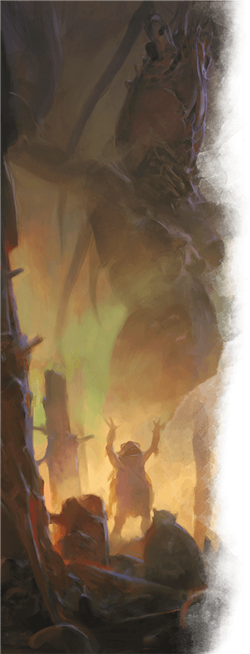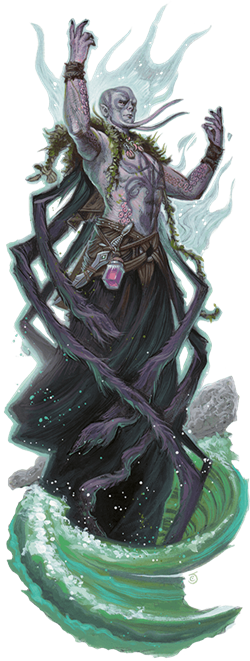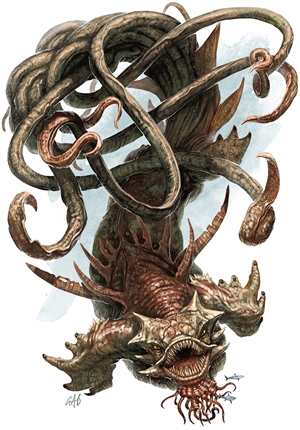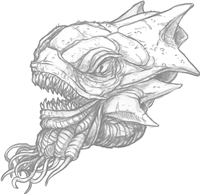How to Play a Kraken like a Force of Nature
A kraken is an ancient terror, long forgotten, rising from the inky depths. It is the tempestuous sea, claiming the lives of those prideful sailors who did not pay the gods proper tribute before embarking on their voyage. It is the primordial ocean, rising up to once more flood the world. A kraken is no mere monster; it is a force of nature, and its power must radiate throughout the world. If you are prepared to have a boss monster spread its influence across your campaign setting, read on.
Campaign Planning: A Force of Nature Affects the World
A kraken is a CR 23 monstrosity. Simply put, this means that most D&D players will never face a kraken in combat, or at least not in a fight that they have any chance of winning. I wouldn’t throw a kraken at a party of anything less than 17th level characters, and even then only if there were at least five characters or unless they were well-outfitted with at least one very rare magic item each. However, this gives you, the Dungeon Master, a unique opportunity to allow a kraken to affect the world long before the characters are ready to face it.
One note on the definition of “force-of-nature antagonist” before we continue. The kraken is not a mindless hurricane of destruction like its fellow elemental titan, the tarrasque. Look at its ability scores: Intelligence 22, Wisdom 18, Charisma 20. This creature is an intelligent, calculating, scheming demigod. However, its mind is so primordial, so ancient, and so unconcerned with the petty whims and foibles of mortal life, it should seem to the players to be an unmotivated force of destruction. Even those mortals who worship it as a god have no understanding of its cosmic plan.
You can even use this to your advantage as a devastating plot twist. Let the players think that the kraken is a dumb titan that embodies the fury of the natural world. Let them delude themselves into thinking that the only way to stop its unerring path of devastation is through brute force. Then you can reveal that the kraken is not simply carving a purposeless swathe of destruction across the countryside. No, the kraken is acting with a purpose. It has an apocalyptic goal that their puny minds can barely comprehend.
Mike Mearls spoke with us about this just the other day. I’ll let him tell it.
Release the Kraken!
 For a monster as devastating as a kraken, its introduction is every bit as important as its epic demise. The Monster Manual gives us one important and easy-to-ignore detail about the kraken: it slumbers for eons, awaiting “some fell sign or calling.” More likely than not, the kraken that your players will fight at 17th level (or higher!) is still taking a mythologically long nap when the campaign begins. Consider the possibilities of what could awaken it. Perhaps a group of kraken priests performs a ritual of awakening and the kraken rises “off-screen,” and the characters only learn of the kraken’s destruction second-hand.
For a monster as devastating as a kraken, its introduction is every bit as important as its epic demise. The Monster Manual gives us one important and easy-to-ignore detail about the kraken: it slumbers for eons, awaiting “some fell sign or calling.” More likely than not, the kraken that your players will fight at 17th level (or higher!) is still taking a mythologically long nap when the campaign begins. Consider the possibilities of what could awaken it. Perhaps a group of kraken priests performs a ritual of awakening and the kraken rises “off-screen,” and the characters only learn of the kraken’s destruction second-hand.
While it may seem insignificant in the grand scheme of things, the inciting incident of your kraken-focused story arc has huge ramifications on the tone of your game! A kraken destroying a city off-screen fits perfectly into a horror-mystery campaign, as the characters must investigate the apocalyptic ruins of a once-thriving civilization in an attempt to piece together what destroyed it. A kraken awoken by a cult’s blood sacrifice fits well into a dark fantasy game, whereas the gods releasing the kraken upon the world fits a more mythic setting.
Also consider how you can get your players involved in the kraken’s awakening. What if the characters themselves unwittingly unleashed the kraken by exploring its ancient resting place? Or even better, what if the characters knowingly awoke the great titan of water in order to combat a greater evil, and now must contend with the monster they’ve personally unleashed upon the world?
But This Time, It’s Personal
Forces of nature are inherently impersonal. They hold no grudges, they simply act according to their innate power and inscrutable desires. This has the unfortunate side effect of making most force-of-nature villains boring and one-dimensional. Whether they’re aware of it or not, players crave conflict with villains that mean something to them. That personal, emotional connection heightens the impact of their conflict. A kraken threatening to destroy the world may be important in the grand scheme of things, but this motivation is hard to relate to. One need look no further than any summer blockbuster where cities get crushed like cardboard. It’s dumb fun, but dumb fun won’t make your campaign one that players will talk about for years to come.
Improve your conflict by giving it emotional stakes! Here are two ways to make dramatic and interesting conflict with a force of nature villain. And if you have another storytelling tactic, please share it in the comments!
A Bridge between Two Worlds. One simple way to make your world-ending conflict personal is to include another, more human villain that acts as an intermediary between the characters and their primordial foe. It is the Renfield to your kraken's Dracula, or the Kalarel the Vile to its Orcus.
 In Princes of the Apocalypse, for instance, each of the four Princes of Elemental Evil were represented by a prophet who sought to summon their primordial master to the Material Plane. These prophets are afforded a bit of backstory in the adventure itself, but they are largely one-dimensional villains to be fought and discarded. Instead of simply having these villains be defeated once in their lairs, as the adventure implied, I expanded their role in the story to encounter and antagonize the characters over and over again.
In Princes of the Apocalypse, for instance, each of the four Princes of Elemental Evil were represented by a prophet who sought to summon their primordial master to the Material Plane. These prophets are afforded a bit of backstory in the adventure itself, but they are largely one-dimensional villains to be fought and discarded. Instead of simply having these villains be defeated once in their lairs, as the adventure implied, I expanded their role in the story to encounter and antagonize the characters over and over again.
Take Gar Shatterkeel, prophet of the Cult of the Crushing Wave. In the worst case scenario, the first time the characters ever encounter this villain is at the climax of the adventure as he attempts to summon Olhydra, Princess of Evil Water. Instead, I had him encounter the characters three times: first when they were too low-level to defeat him, and he took them prisoner in Rivergard Keep, again when he led an attack on the village of Red Larch with a devastation orb, and third when he confronted them in the Plane of Water (my own addition to the adventure). There, he managed to curse one of the player characters before finally being killed.
By the third encounter, the players had learned to hate this prophet of Olhydra. And by cursing a character during his final appearance—essentially killing her, in this instance—he reminded the entire party of the power of his evil demigod master. As god-like titans themselves, krakens can bestow their priests with similar power.
Use the Cataclysm as a Backdrop. The end of the world is a crucible that reveals the best and worst of humanity. Think of The Walking Dead. The zombies in that show aren’t the real villain, though they are a constant danger. The true enemies of humanity in an apocalypse are… humans. This can play out in innumerable ways throughout your campaign:
- When the kraken first awakens and destroys a coastal metropolis, the characters have to not only escape the beast’s destruction, but also contend with the looters stealing from destroying shops and mugging fleeing civilians.
- With the local navy destroyed in the initial attack, pirates grow bolder, attacking even large settlements with weapons scavenged from derelict ships.
- Doomsday prophets and kraken priests raid towns and cities alike by night, kidnapping youths to use as blood sacrifices in rituals that will protect them from the apocalypse.
If you like using monsters over humanoids as enemies, you can also have monsters flood into the world as a result of kraken’s appearance.
- Since the kraken is amphibious and carries storms with it as it moves, dry inland regions flash-flood and become salty swamps rife with lizardfolk.
- Dark cave systems fill with water and become breeding grounds for kuo-toa.
- Even as the kraken moves across the land, the drowned arise as sea spawn—perhaps after being offered a Davy Jones-style bargain—and begin to terrorize the coast as servants of their new master.

Even in Sleep, the Kraken Distorts Nature
An awakened kraken is a creature on the warpath, and thus one seldom in its lair. Generally speaking, the only time a kraken should be in its lair is if it is slumbering, if it has only just awoken, or if it is aware of threat to its existence so terrible that it must stop enacting its ancient schemes.
A party of high-level adventurers, for instance.
However, even before the characters set out to defeat a kraken, you should consider how its mere existence affects the world around it (in a 6-mile radius). The Monster Manual gives three ways in which the environment around a kraken’s lair warps as a result of its primordial power—it can control the weather, water elementals form within the water, and aquatic creatures grow hostile. And all of these strange events occur even when the kraken is dormant. I would even say that a slumbering kraken can control the weather through its dreams, creating unpredictable and deadly weather.
A way to make your kraken more like a natural disaster incarnate is to allow these regional effects to follow the creature itself anywhere it goes, not just around its lair.
In Combat: The Kraken Unleashed
Fighting a kraken means fighting in the most disadvantageous of circumstances. Often (but not always) you’ll be underwater or on the deck of a ship, which means that not only will you be fighting the kraken, you’ll also be trying to survive the compassionless sea as well. Be sure to refer to the Underwater Combat section of the Player’s Handbook and perhaps also the Underwater Random Encounters table from Xanathar’s Guide to Everything, if you’re in need of creatures to dissuade the characters from entering the sea. Be sure the characters know they’re about to fight underwater. If you watched Critical Role’s first campaign, you know how disastrous being unprepared for fighting a kraken underwater can be.
A Kraken’s Minions
 While a force of nature like a kraken can rely on its pure brute force to destroy almost anything in its path, a kraken is also intelligent enough to be a tactical grandmaster. Just like an ancient red dragon, a kraken should have learned everything there is to know about the player characters through its servants, the kraken priests.
While a force of nature like a kraken can rely on its pure brute force to destroy almost anything in its path, a kraken is also intelligent enough to be a tactical grandmaster. Just like an ancient red dragon, a kraken should have learned everything there is to know about the player characters through its servants, the kraken priests.
Kraken priests make for excellent boss encounters at lower levels, but by the time characters are powerful enough to fight a kraken, these CR 5 creatures are barely strong enough to put a dent in the characters’ hit points. Which means they’re the perfect minions for a kraken boss fight! You can also spice up the fight with a few marids bound to serve the kraken, 1d6 giant sharks driven mad by the kraken’s power, or an evil storm giant that serves as the kraken’s lieutenant.
A Kraken’s Traits
A kraken possesses more than a dozen powerful combat traits that you need to know backward and forward in order for it to fight at peak effectiveness. Here’s a rundown:
Defenses. A kraken possesses a frightful array of defenses, but its Armor Class and hit points are both actually below average for a creature of its challenge rating. It’s immunity to lightning damage and all damage from nonmagical weapons is impressive, but one would expect every character to have at least one magical weapon by the time they’re fighting a creature of this magnitude. Its immunity to being frightened and paralyzed (via hold monster, for instance) is impressive, but its most impressive defensive ability are its incredible saving throws. Note that these saving throws are important because, unlike other legendary creatures, the kraken does not have the Legendary Resistance feature.
With proficiency in every saving throw except Charisma, this creature laughs at even the most powerful spells. Against a 20th-level wizard (spell save DC 19, without any magic items), the kraken only has to roll an 8 or higher to succeed on a Wisdom saving throw, or only a 5 or higher to succeed on a Constitution saving throw! You really want to goad the players into casting spells at the kraken.
Movement. The kraken has a swim speed of 60 feet, which isn’t terribly impressive, but it’s still probably faster than most of the party. Its 20-foot walking speed is lackluster, but a kraken rarely fights on land unless it has to. However, its Freedom of Movement trait allows it to easily avoid being restrained or have its movement reduced by spells, and allows it to escape grapples with ease, essentially preventing its movement from ever being reduced.
Truesight. truesight is the most powerful sensory ability in Dungeons & Dragons, and the kraken has it out to 120 feet. That means it’s impossible to blind it with darkness, sneak up on it by becoming invisible, fool it with illusions or transmutations, and even to sneak up on it by traveling through the Ethereal Plane with etherealness! Long story short, as long as the kraken isn’t asleep, it will know you’re coming.
Amphibious. Contrary to most players’ assumptions, the kraken can fight on both land and sea. Its subpar land speed makes it a poor idea for the kraken to go too far inland, but this does allow it to climb up onto the deck of a ship or onto an island to get into close quarters when necessary.
Siege Monster. This trait rarely comes into play, but it allows the kraken to deal double damage to objects and structures, which helps it stop the party from using cheesy strategies involving Daern’s instant fortress or spells like wall of stone. Otherwise, it’s best to just handwave the minutiae of destroying buildings unless the characters are using it as a defensive fortification. Then it might be worth it to break out the rules for object hit points and Armor Class in the Dungeon Master’s Guide.
 Tentacles. The kraken has a powerful suite of attacks that deal more than just pure damage. First, its Multiattack action allows it to make three tentacle attacks (with an impressive 30-foot reach!), which in addition to doing damage also automatically grapple any creature hit by them. This instant grapple is vital to the kraken’s other actions.
Tentacles. The kraken has a powerful suite of attacks that deal more than just pure damage. First, its Multiattack action allows it to make three tentacle attacks (with an impressive 30-foot reach!), which in addition to doing damage also automatically grapple any creature hit by them. This instant grapple is vital to the kraken’s other actions.
Fling. Any creature grappled by these tentacles can be thrown 60 feet “in a random direction,” dealing damage tohe creature based on how far it was thrown, and any creature hit by the thrown creature takes an equal amount of damage. This is a powerful attack, but if you’re open to houserules, you may want to consider an idea also developed by the The Monsters Know What They're Doing blog and allow the kraken to fling creatures at a specific point instead of a random one. As they suggest, you can also make your kraken more deadly by considering the surface of the water as solid for the purposes of dealing damage to simulate the effects of surface tension. A particularly cheeky kraken might even make a Dexterity (Acrobatics) check to skip an unfortunate character across the water, causing them to travel a number of additional feet equal to the result of the check (but dealing no extra damage).
Bite. This attack is so powerful against grappled creatures that it can’t be used as part of the kraken’s Multiattack routine. If the kraken bites a Large or smaller creature it’s grappling, it swallows it, which not only deals major damage to the creature, but also will take it out of the fight for at least one round.
Lightning Storm. This incredibly powerful ability deals about the same amount of damage as a full Multiattack, but comes with the benefit of a massive 120 foot range (though it lacks the tentacle attack’s vital automatic grapple feature). Generally, using a tentacle attack is better, but Lightning Storm is an excellent attack to use against enemies that escape the range of the kraken’s melee attacks.
Legendary Actions. Legendary actions that allow you to act “out of turn” are immensely helpful in improving your boss monster’s action economy. Essentially, it helps the monster stay in the fight even when it’s fighting solo against a team of four or five characters. Generally speaking, just making an extra tentacle attack is the best thing you can do with the kraken’s legendary actions, but Ink Cloud can essentially turn the kraken invisible for a round.
Lair Actions. Krakens are rarely fought in their lairs simply because most krakens are on the warpath at all times (see the introduction to this section). But if a kraken can lure characters to its lair or if it retreats there after being injured, the heroes are in for a rough fight. Unlike other legendary creatures, the kraken can use the same lair action as many rounds in a row as it wants. Generally speaking, this means that the most effective strategy is just to use the third lair action (see its stat block) to deal area-of-effect lightning damage over and over again, but if the kraken has some kraken priest allies that can call lightning, using the second lair action to give the heroes vulnerability to lightning damage becomes a devastating tactic.
A Kraken’s Tactics
Obviously, your kraken must change its tactics to reflect the strengths and weaknesses of its enemies and the changing tides of battle. However, this is a simple combat loop that you can use to relieve some of the pressure of using a powerful monster.
- If the kraken can see the characters as they approach, use Call Lightning to attack any spellcasters. The damage may break their concentration on pre-battle buff spells. If they’re approaching on a vessel, consider using Call Lightning to destroy the vessel, forcing them to use spells or swim to engage the kraken.
- If in its lair, use the “strong current” lair action to force characters away for as long as possible if there are paladins or other powerful melee-focused combatants. If not, use the area-of-effect lightning damage lair action at the start of each turn.
- Once the characters are in melee range, use tentacle attacks to grapple characters, starting with spellcasters. Once a spellcaster is grappled, use your bite attack to swallow them as soon as possible. By blinding and restraining casters, you make it impossible for them to use spells that require line of sight.
- Once one character is swallowed, use your fling action to deal major damage to all other characters. Ideally, fling melee combatants into back-line spellcasters, dealing damage to both characters.
- Always try to have one character swallowed at a time. Using tentacle attacks as legendary actions will help you do this, even though you can’t bite as part of your Multiattack.
Having Fun as a Force of Nature
 This guide exists as a way to take some of the pressure of tactical combat off in the heat of the moment—all in the support of your fun. If anything in this guide gets in the way of having fun or playing the game in the way you want to, you should discard it immediately and replace it with an idea of your own.
This guide exists as a way to take some of the pressure of tactical combat off in the heat of the moment—all in the support of your fun. If anything in this guide gets in the way of having fun or playing the game in the way you want to, you should discard it immediately and replace it with an idea of your own.
This includes playing the kraken as a mindless beast instead of an intelligent titan. If you want to play a kraken as essentially an aquatic tarrasque, that’s valid, and it won’t make your game any less fun. It’ll just make it your own.
How do you prefer to play a kraken? As a scheming elemental mastermind, as a natural disaster made flesh, or something in between? Let us know in the comments!
 James Haeck is the lead writer for D&D Beyond, the co-author of the Critical Role Tal'Dorei Campaign Setting, and a freelance writer for Wizards of the Coast, the D&D Adventurers League, and Kobold Press. He lives in Seattle, Washington with his adorable forces of nature, Mei and Marzipan. You can usually find him wasting time on Twitter at @jamesjhaeck.
James Haeck is the lead writer for D&D Beyond, the co-author of the Critical Role Tal'Dorei Campaign Setting, and a freelance writer for Wizards of the Coast, the D&D Adventurers League, and Kobold Press. He lives in Seattle, Washington with his adorable forces of nature, Mei and Marzipan. You can usually find him wasting time on Twitter at @jamesjhaeck.








-
View User Profile
-
Send Message
Posted Apr 4, 2018Sorcerer with Heightened Spell + Polymorph turns the Legendary Resistance-less kraken into a kitten, drops it into a bag of holding, and tosses the bag of holding into a portable hole 20ft away.
-
View User Profile
-
Send Message
Posted Apr 4, 2018Sorcerer and rest of party get chain counter spelled by cabal of evil archmages in service to the Kraken and seeking to hasten the end of the world so that they might rule over the remains.
-
View User Profile
-
Send Message
Posted Apr 4, 2018-
View User Profile
-
Send Message
Posted Apr 4, 2018Whoops! Which creature is this? :O
And another:
The cloud spreads around corners, and that area is heavily obscured to creatures other than the kraken.
-
View User Profile
-
Send Message
Posted Apr 4, 2018While you are technically correct, I think any DM worth his salt would put in something to prevent this either by adding some usage of legendary resistance or making it immune to hostile shapechange. Otherwise thats just silly and a little bit awesome lol.
-
View User Profile
-
Send Message
Posted Apr 4, 20181d6 [Tooltip Not Found] driven mad by the kraken’s power (hyperlink not found)
-
View User Profile
-
Send Message
Posted Apr 4, 2018-
View User Profile
-
Send Message
Posted Apr 5, 2018You guys have really started to smash it with the content you're bringing out, keep up the good work
-
View User Profile
-
Send Message
Posted Apr 5, 2018So using this. My current campaign is partially set on a water world. Perfect.
-
View User Profile
-
Send Message
Posted Apr 5, 2018This is awesome, love these articles! Brings a ton of inspiration in my mind to bring back to the table.
-
View User Profile
-
Send Message
Posted Apr 5, 2018James, thanks for writing this. It's thoughtful, creative, and makes me want to steal all of your ideas. Well done, good sir.
-
View User Profile
-
Send Message
Posted Apr 5, 2018In my campaigns, I mostly use krakens to represent Cthulhu like beings or other elder gods. This article was really helpful.
Overall, i'm really liking these articles. I'd really like to see a "How to Play a Yuan-Ti Like a..." one. The serpent folk have had no mention in any of these articles, despite being a famous monster.
-
View User Profile
-
Send Message
Posted Apr 5, 2018Even with disadvantage, it'd be fairly decent shot to resist on the first try. And that's assuming the kraken even lets the sorcerer get the spell off; with a 22 INT, the kraken would be able to easily identify and deal with the spellcasters long, long before they became a threat. Of course, with a clever plan, the PC group could come up with a counter. But just 'Polymorph it, lulz' probably wouldn't work with a DM that was paying attention.
-
View User Profile
-
Send Message
Posted Apr 5, 2018Im really loving these articles! I think what I like the most is how you took Gar Shatterkneel and humanity and made them bigger threats. A kraken of course is the major threat. But nothing really screams chaos like humans during the apocalypse.
I think if I had a kraken I would make it come out fairly early maybe level 10. But have hints as soon as the game starts. When the kraken appears Id make the insueing chaos one of the primary conflicts.
-
View User Profile
-
Send Message
Posted Apr 5, 2018Love these so much!
Even if I don't use the monsters themselves they are interesting enough to apply to homebrew or other monsters even!
An interesting aspect too would be not just how the leader acts moving his pieces about, but to go more in-depth into how the mid-boss would function. Too often they are treated as just strong lackeys (Even though you write a bit of how you fleshed out one in your campaign) when there is so much more room for not just personality, but the ability to become a main threat in their own right. Oftentimes too it seems like 'The Heavy' of the chessmaster ends up becoming more intertwined with the players as well being the muscle behind the leader's often vague goals and quests.
-
View User Profile
-
Send Message
Posted Apr 6, 2018Right? I think I'd have them drop him in the top as a kitten as he almost immediately rips through the bottom of the bag as a kraken... with fur. Okay, I'm kidding about the fur, but that would be fierce, right?
-
View User Profile
-
Send Message
Posted Apr 8, 2018This article was perfect timing for me as a new DM. It has made me think about the specific campaign and world we're in, but also about approach to developing a campaign (especially in terms of gradual build-up to a boss battle).
I decided to make a world where adventuring is kind of like The Amazing Race or something you do for sport, where a party goes out to adventure not only to satisfy their individual needs, but to gain notoriety, have their deeds published in a sort of graphic novel, get paid, etc. Originally, it was just that the seedy shadow company was using this for their own interests in expansion and colonization. One of my players put in some time to develop backstory - a destroyed temple [earthquake] and lost 'family' members from its orphanage. And then the company is tearing open portals to Mechanus and snatching out Modrones to come do labor in the colonies - farming, construction, eventually the printing of the books.
Now I have a mechanism to tie ALL of this together - The company's portal-snatching awoke the Kraken, which indirectly destroyed the temple, and now there's going to be a campaign-long struggle between Order (the company) and Chaos (the Kraken).
-
View User Profile
-
Send Message
Posted Apr 8, 2018Welcome to DMing! I'm a 25 year DM veteran, and this is an excellent idea. Be prepared for your party to throw an absolute monkey wrench in all of your plans and most importantly ... remember to have fun!
-
View User Profile
-
Send Message
Posted Apr 9, 2018I really enjoy these articles, continue making them! They're a great read :D
-
View User Profile
-
Send Message
Posted Apr 10, 2018I really appreciate this article's willingness to reference outside sources in discussing monster. Goes a long way to establish the series as building off of the community's work rather than trying to replace it.